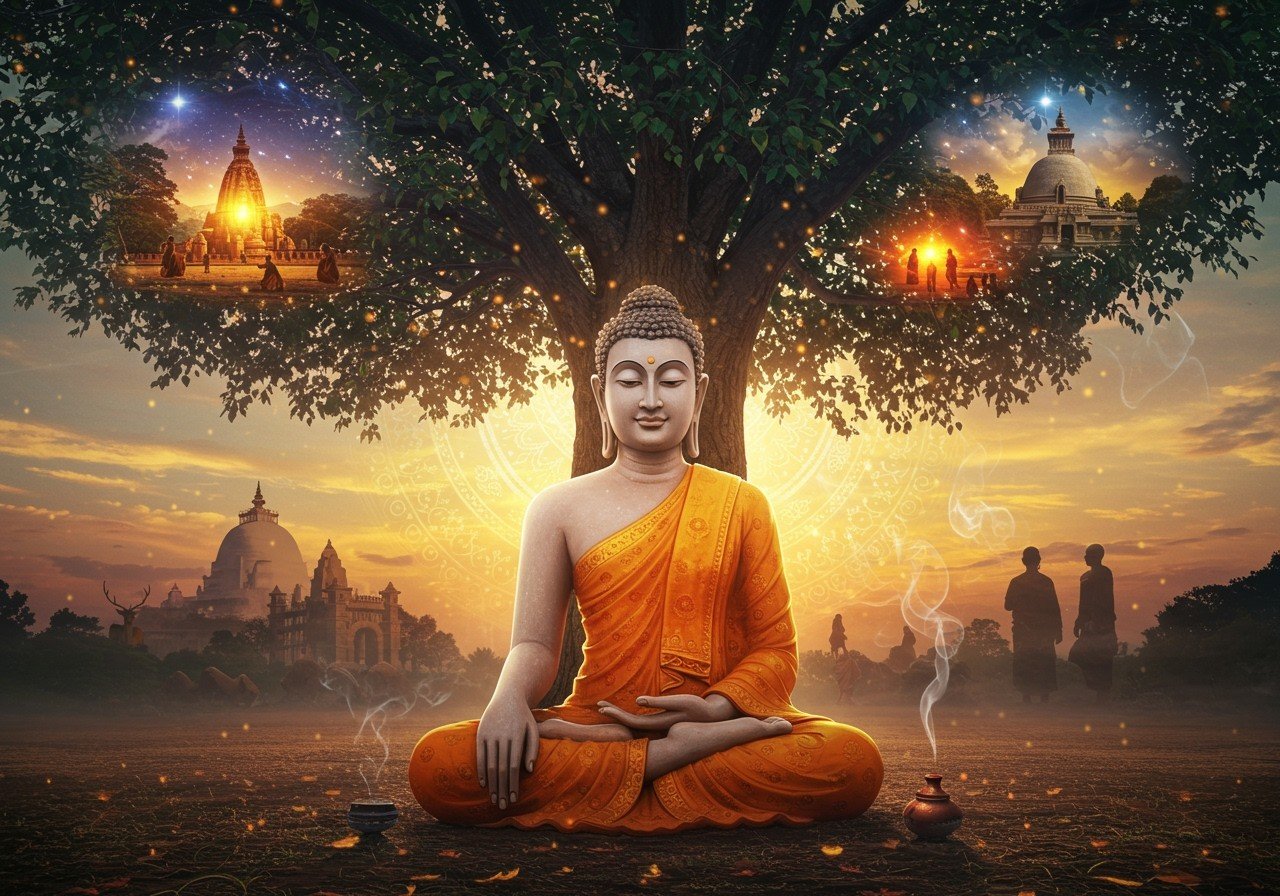
Buddhism, one of the world’s oldest religions, has profoundly influenced various cultures and traditions. This blog aims to provide a clear explanation of Buddhism’s origin and how it flourished over time. Understanding the roots of Buddhism can offer valuable insights into its teachings and practices. For a deeper dive into specific deities and sacred sites, explore our articles on Maa Manasha, Krishna, Vishnu, Indra, the Leaning Temple of Huma, and Odisha’s sacred sites.
Origins of Buddhism
Buddhism emerged between the mid-6th and mid-4th centuries BCE in the Indian subcontinent, specifically in what is now Nepal. Siddhartha Gautama, later known as “The Buddha,” was born into a royal family but relinquished his privileged life in search of spiritual awakening. He was deeply troubled by the suffering he witnessed in the world and sought a way to transcend it. His journey led him to found a new spiritual path, which eventually became known as Buddhism.
Key events in his life include:
- The Four Sights: Witnessing an old man, a sick person, a dead body, and an ascetic monk profoundly impacted Siddhartha. These sights revealed to him the pervasiveness of suffering in human existence and sparked his quest for liberation.
- The Middle Way: Siddhartha experimented with various spiritual practices, including extreme asceticism, but found them ultimately unsatisfying. He realized that true liberation lay in a balanced path, avoiding both excessive indulgence and extreme self-denial. This balanced approach became known as the Middle Way.
- Enlightenment: While meditating beneath a Bodhi tree, Siddhartha attained enlightenment, a state of complete awakening and understanding of the nature of reality. This transformative experience marked the beginning of his journey as a teacher and the foundation of Buddhist philosophy.
Early Spread of Buddhism
After attaining enlightenment, the Buddha dedicated his life to sharing his insights, attracting numerous followers. Buddhism rapidly disseminated throughout India through various channels:
- Monasteries: These served as crucial centers for Buddhist learning, practice, and community life. Monks and nuns resided in these monasteries, studying the scriptures, meditating, and upholding the principles of the Dharma.
- Emperor Ashoka: A pivotal figure in Buddhist history, Emperor Ashoka embraced Buddhism after witnessing the devastation of war. He actively promoted the teachings through edicts inscribed on pillars and rocks throughout his vast empire, significantly contributing to its spread.
- The Sangha: The Sangha, the community of Buddhist monks and nuns, played a crucial role in preserving and transmitting the Buddha’s teachings. Through their dedicated practice and adherence to the monastic code, they ensured the continuity of the Dharma.
Oral traditions and early Buddhist councils were essential for maintaining the integrity of these teachings. These councils helped to clarify and codify the Buddha’s teachings, ensuring that they were passed down accurately through generations.
Expansion Beyond India
Buddhism extended its reach far beyond India, permeating diverse regions of Asia:
- Sri Lanka: Buddhism arrived in Sri Lanka through missionaries sent by Emperor Ashoka, establishing a strong Theravada tradition that continues to flourish on the island to this day.
- Southeast Asia: As Buddhism spread to Southeast Asia, it adapted and integrated with local cultures and beliefs, giving rise to distinct forms of Buddhist practice in countries like Thailand, Myanmar, and Cambodia.
- Central Asia and East Asia: Trade routes like the Silk Road facilitated the transmission of Buddhism to Central and East Asia. It took root in countries like China, Korea, and Japan, evolving into various schools and traditions, including Mahayana and Zen Buddhism.
In each region, Buddhism intertwined with local traditions, enriching its practices and teachings while also influencing the cultural landscape.
Development of Different Schools
As Buddhism spread across different cultures, it diversified into various schools of thought:
- Theravada Buddhism: This school emphasizes the earliest texts and teachings, particularly the Pali Canon (Tripitaka). It focuses on individual enlightenment through meditation and mindfulness.
- Mahayana Buddhism: Mahayana Buddhism emphasizes compassion and the Bodhisattva ideal, where practitioners strive not only for personal enlightenment but also to help all beings achieve liberation.
- Vajrayana Buddhism: Vajrayana Buddhism incorporates Mahayana teachings with esoteric practices, including mantras, mandalas, and visualizations, to accelerate the path to enlightenment.
Each school possesses unique doctrines, practices, and significant figures, contributing to the rich tapestry of Buddhist thought and tradition. Poojn.in offers a wide selection of items relevant to these diverse traditions, including mala beads, statues, and incense.
Buddhism in Modern Times
Buddhism continues to flourish in the modern world, adapting to contemporary contexts while retaining its core principles:
- Japan: Japan is renowned for Zen Buddhism, a school that emphasizes meditation and mindfulness as paths to enlightenment. Zen practices have gained significant popularity in the West.
- Thailand: Theravada Buddhism is the predominant form of Buddhism in Thailand, with a strong emphasis on monastic traditions and the study of the Pali Canon.
- United States: There is a growing interest in mindfulness and meditation practices derived from Buddhism in the United States, often integrated into secular settings for stress reduction and well-being. Discover ways to overcome common meditation challenges.
Contemporary figures like the Dalai Lama and Thich Nhat Hanh have made significant contributions to spreading Buddhist teachings globally. Modern lifestyles often incorporate Buddhist practices such as mindfulness and meditation, highlighting its timeless relevance. You can find helpful resources and products for your practice on poojn.in, such as meditation malas and inspiring statues.
Conclusion
Buddhism’s journey from its origins in ancient India to its global presence today testifies to its profound teachings and adaptability. Understanding its origins and flourishing provides a deeper appreciation for its rich history and enduring relevance. For those who value tradition and seek authentic ritual items, embracing Buddhist wisdom can be a meaningful addition to their spiritual practices. Poojn.in offers a curated selection of products to support your journey.


